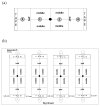Volatile Characterization of Lychee Plant Tissues (Litchi chinensis) and the Effect of Key Compounds on the Behavior of the Lychee Erinose Mite (Aceria litchii)
- PMID: 37371513
- PMCID: PMC10296336
- DOI: 10.3390/biom13060933
Volatile Characterization of Lychee Plant Tissues (Litchi chinensis) and the Effect of Key Compounds on the Behavior of the Lychee Erinose Mite (Aceria litchii)
Abstract
Herbivore-Induced Plant Volatiles (HIPVs) are volatile signals emitted by plants to deter herbivores and attract their natural enemies. To date, it is unknown how lychee plants, Litchi chinensis, respond to the induction of leaf galls (erinea) caused by the lychee erinose mite (LEM), Aceria litchii. Aiming to reveal the role of HIPVs in this plant-mite interaction, we investigated changes in the volatile profile of lychee plants infested by LEM and their role on LEM preferences. The volatile profile of uninfested (flower buds, fruit, leaves and new leaf shoots) and infested plant tissue were characterized under different levels of LEM infestation. Volatiles were collected using head-space-solid phase microextraction (HS-SPME) followed by gas chromatography-mass spectrometry (GC-MS) analyses. Fifty-eight volatiles, including terpenoids, alcohols, aldehydes, alkanes, esters, and ketones classes were identified. Using dual-choice bioassays, we investigated the preference of LEM to uninfested plant tissues and to the six most abundant plant volatiles identified. Uninfested new leaf shoots were the most attractive plant tissues to LEM and LEM attraction or repellence to volatiles were mostly influenced by compound concentration. We discuss possible applications of our findings in agricultural settings.
Keywords: behavioral bioassays; eriophyoid mites; gas chromatography-mass spectrometry (GC-MS); head-space-solid phase microextraction (HS-SPME); herbivore-induced plant volatiles (HIPVs).
Conflict of interest statement
The authors declare no conflict of interest.
Figures











References
-
- Dudareva N., Negre F., Nagegowda D.A., Orlova I. Plant Volatiles: Recent Advances and Future Perspectives. Crit. Rev. Plant Sci. 2006;25:417–440. doi: 10.1080/07352680600899973. - DOI
-
- Dicke M., Loon J.J.A. Multitrophic Effects of Herbivore-induced Plant Volatiles in an Evolutionary Context. Entomol. Exp. Appl. 2000;97:237–249. doi: 10.1046/j.1570-7458.2000.00736.x. - DOI
Publication types
MeSH terms
Substances
Associated data
LinkOut - more resources
Full Text Sources
Miscellaneous

